The skills required for team leadership have changed.
Today we value collaboration over experience. We value inspiration over control. We value knowledge-sharing over tenure. We value vulnerability over bravado. We value leaders who can coach us throughout the quarter or year, not just those who will analyze our performance afterwards.
The current environment has made learning to lead even harder. Leadership now means navigating a wide variety of situations and a lot of hard conversations with little guidance or training. Many of us have been left to learn management skills on our own, with books and blogs as our primary resources.
Leaders today aren’t expected to have all the answers, but they must create an environment in which their teammates can learn and grow. Teams have members with more diverse skill sets than ever before, and leaders direct teams in disciplines for which they have less functional experience. Overall, fewer leaders get management training and apprenticeship because of the dynamic, rapid pace of today’s work world.
While constant and disruptive change is the new norm, there is one thing that will always be true.
Leadership is a learnable skill.
Leaders can develop their own style of leadership based on their individual strengths, and this is the key to becoming an authentic leader. By developing your own leadership approach and understanding how and why great teams work, leaders gain confidence in building teams, and those teams perform well.
This guide will explore how team leaders can develop the skill of building great teams. As the title suggests, the purpose of writing this eBook is to share a practical roadmap for coaching any business team to sustainable high performance. As you read it, you’ll see how it’s about much more than measuring performance. When you’re done, you’ll have a practical map for how to coach your team.

It starts with self-discovery
Understanding your strengths
The key to being a great leader is understanding your strengths and potential blindspots. This is important because doing so helps you understand the impact you can have on different personality types. It’s also important for building confidence as a leader. Understanding strengths helps you to have conviction in leadership situations, while knowing your potential blindspots helps you identify when to seek counsel.
Personality at work
Leadership requires us to flex our soft skills (though there isn’t anything “soft” about them). Our soft skills are based on our personality. Though we are all a unique mix of nature and nurture, there are personality frameworks that help us better understand our own personality and the personalities of others.
DISC is a widely-used personality assessment that highlights how our personalities manifest at work. Created by Psychologist William Moulton Marston in 1928, DISC categorizes our personality into four archetypes: Dominance, Influence, Steadiness and Conscientiousness. Because humans are rarely one thing, DISC includes personality profiles that mix combinations of the four archetypes, such as DI or SC. DISC also measures our ability to work with other personality types, a key skill that helps leaders have empathy for various personalities on a team.
The first step in understanding your strengths is to take a personality assessment to determine where you land on DISC. (There are many free online DISC assessments to choose from or you can take it for free from within your Teaming account.) After you take the assessment, you’ll get a custom report that shares your DISC type, including your strengths, potential blindspots, what motivates you, and what drains you.
Next, it’s important to reflect on what the report tells you about yourself. Reflect deeply on the areas of your personality that you may not have realized were there.
Lastly, take time to reflect on how your strengths have helped you in the past and where your blindspots may have hindered you. Based on your strengths, decide where you want to focus on improving.
Engaging others
Now that you know more about your personality in the workplace, it’s important to understand how you typically engage with other personality types in different situations. For example, D-type personalities tend to be quick, firm decision-makers. This trait can be game-changing in a crisis, but it can also be perceived as thoughtless and blunt during consensus-driven decision-making.
Turning DISC from a framework into a practical, real-life application for you and your team is simple. Invite your team members to take the DISC assessment and ask them to share the results with you and the rest of the team. Some team members may not feel comfortable sharing their results with others. The best way to combat this is to share your results with the rest of your team before asking them to do the same. (Leaders should always be vulnerable first to build trust and create psychologically safe team environments.)
There are many benefits to reading each other’s DISC reports. Team members will learn how to collaborate better, and you will learn more about how to engage, inspire and support each team member. Even if you think your team is working well together already, the DISC framework will make team collaboration more effective.
Now that you have a deeper understanding of your strengths and potential blindspots, plus a blueprint of the team personalities, you’re ready to coach. Coaching is a way of using your personal strengths to identify how you can best support the team and its members, not a one-size-fits-all leadership style.
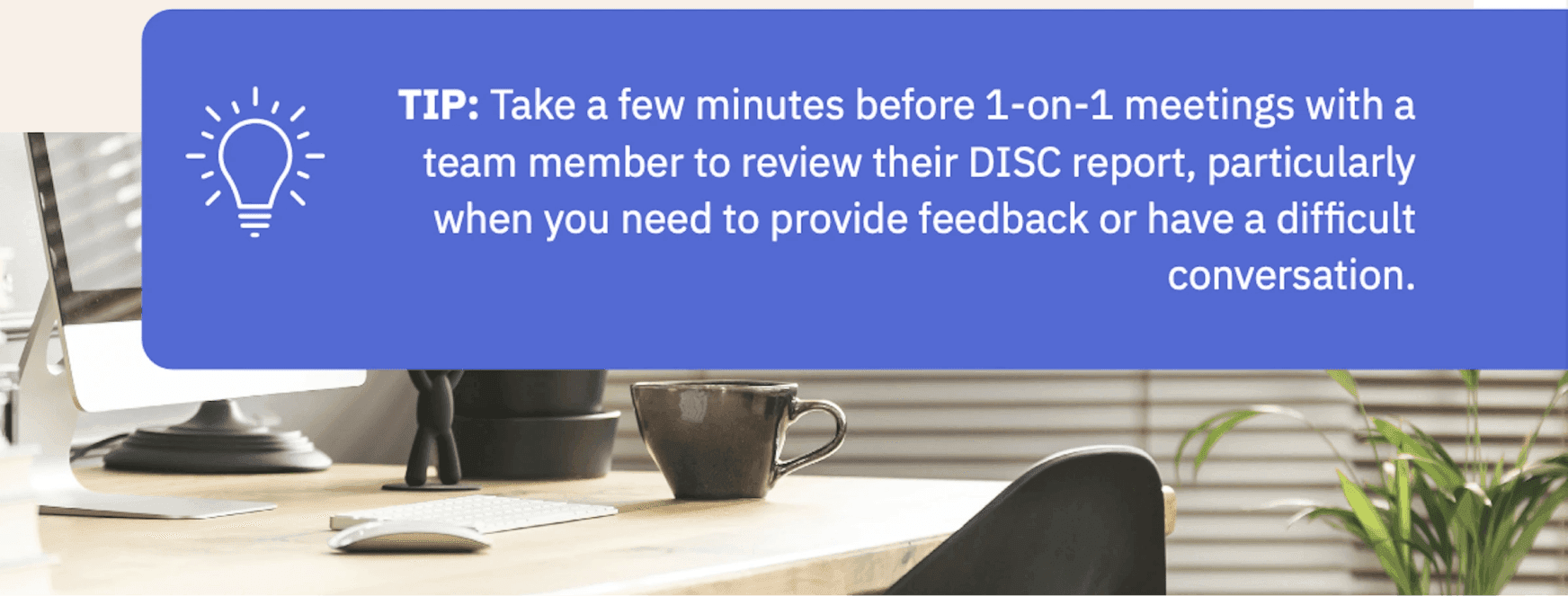
Coaching
Google conducted a 10-year study, Project Oxygen, to understand what made the most effective leaders. In 2008 and again in 2018, Googlers ranked “being a good coach” as the most important attribute for their manager to have – even more important than being results-oriented, a good decision-maker, or having a strong vision.
Sometimes it’s hard to see yourself as a coach. You might be like many leaders, who feel tension between the responsibility and authority of your position and the collaborative, supportive nature of coaching. Coaching is simply a way of identifying the needs of a team and each member at any given time and supporting them throughout the team’s lifespan.
Coaching is most meaningful for the team when individuals get 1-on-1 coaching and they’re a part of a team that’s collectively coached. When you think of your job as coaching each individual and the collective team, you unlock something important for everyone finding purpose and meaning in work.

Coaching team members
Coaching is about being able to adapt to the needs of the team. You can identify the changing need for individual team members with the GROW model.
The GROW model
Devised in the 1980s by Sir John Whitmore, GROW involves four steps:
Goal
Establish a goal
Establish what your team member wants to accomplish at the beginning of a coaching discussion. It can be their goals for a project, career aspirations, clarity around their role in the organization, or what they hope to get out of something in particular. Team members can have a hard time being direct about what they hope to achieve with your support, and may need help articulating it. A good way to start is to ask something like, “What do you want when you walk out the door that you don’t have now?” or “What will things be like for you in a month from now without addressing this?”
Reality
Examine the current reality
With the goal of your conversation established, ask questions rooted in what, when, where and how to help focus your conversation on facts. This sets a constructive tone for the conversation. You’ll want to avoid “why” questions because asking “why” demands that people explore reasons and motivations rather than facts. In doing that, it can carry overtones of judgment or trigger attempts at self-justification, both of which can be counterproductive. If your team member offers “whys” in the conversation, avoid reacting to them so that you can ask more what, when, where questions, with one important exception. When being offered “whys” with a lot of emotion, particularly when it’s unusual for them to do so, you should pause the conversation and acknowledge how this situation is hard for your team member.
During this stage, a good reality focused question to ask is, “What are the key things to know?” Pay special attention to how team members respond. Are they missing something important? Typically you can identify what they might be missing in a situation when you listen for two things in responses: exclusively addressing operational issues or exclusively addressing people problems.
This stage helps your team member slow down and think critically, and they often lose themselves in contemplation. In slowing down to communicate the problem effectively, you’ll often find that they identify the problem on their own. For example, they might realize that they didn’t address an important operational step or forgot to include someone in an important decision. When team members can identify the problem themselves, they engage with new energy and a fresh perspective. This coaching approach stops people from overlooking pertinent variables and leaping to conclusions. It also supports the dynamic that they’re accountable for solving their own problems.
Options
Explore options
When team members come to you for coaching, it might be because they feel stuck. They might say something like, “I’m torn between...” or “My only option is…” When you hear these prompts, it’s time to help them think more broadly and deeply. To broaden the conversation, ask something as simple as, “What would you do if you could wave a magic wand?” People find this type of question freeing, and it often leads to thinking in new, productive ways. Once they’ve broadened their perspective and discovered new options, prompt them to deepen their thinking to assess the strengths, weaknesses and risks of each option.
Will
Establish the will
Ask something like, “What will you do now?” This encourages the team member to create or review a specific action plan. If the conversation has gone well, your team member has a clear sense of what that plan is. If they don’t, you may want to cycle back through the earlier steps of the GROW process and help them define how they’ll attack the problem. This step doesn’t always naturally come up in conversation, so use private meeting notes to give yourself a prompt for remembering this step.
Coaching takes more than one session to be effective, especially if it’s breaking previously established norms for your 1-on-1s. But when you notice your team members are growing increasingly inquisitive, asking good questions and working from the premise that they don’t have all the answers, that’s how you know your coaching is effective.
The GROW model is great to use in 1-on-1s, but coaching can also happen outside of 1-on-1s in brief exchanges or even online chats. In brief exchanges, you might respond to a request for help by posing a single question, such as “What are possible solutions you’ve thought of?”

Coaching the team
Coaching the team is fundamentally the same as it is for individuals but with a different framework for teams. The framework to effectively coach teams is Team Health.
What is Team Health?
Team Health is your team’s ability to achieve its collective mission, meet or exceed the expectations placed upon it, and effectively adapt to the dynamic environment in which it operates.
Similar to how our personal health can either enable or hinder what we are capable of in our personal lives, a team’s health greatly affects what a team can ultimately accomplish. Team Health is the collection of seven fundamental team dimensions:
Trust and Psychological Safety
Productive Conflict
Commitment to the Team
Active Accountability
Focus on Achieving Team Goals
Positive Impact
Personal Purpose and Meaning
These dimensions are based on research performed by Google in Project Aristotle and Project Oxygen, which are studies of their internal teams and their managers respectively, by Deloitte’s Human Capital Trends survey analysis, and Gallup’s employee engagement research over the last 50 years. This research focused on discovering the universal truths of high-performing teams. The research finds that characteristics traditionally thought to enable high performance, like educational backgrounds, work experience, individual performance and colocation of the team, do not play a significant role in a team’s effectiveness.
Instead, the research reveals the seven core dimensions that determine a team’s effectiveness. Contrary to the more individual-focused characteristics traditionally considered most important, these dimensions focus on how well a team works together and supports its members.
Notably, there is significance to the ordering of these dimensions, as preceding dimensions provide foundational support for the dimensions that follow. By far the most impactful dimension on team performance is psychological safety.

Trust and Psychological Safety
What it means
Within an environment of genuine care for each other, team members feel free to be vulnerable and share their opinions, and they don’t fear making or admitting mistakes.
Trust and psychological safety are highly dependent on each other, and the combination of the two is the foundation of any team’s health. Low trust and safety within a team creates a barrier for building healthy teams, while a solid foundation paves the way for the team to grow their health in the other dimensions.
Trust expresses the level of confidence team members feel as to whether or not their teammates will consistently act in the best interests of the team, and how much they can rely on fellow team members. Trust is created from individual relationships, making the development of interpersonal relationships within the team critical.
Psychological safety, a concept popularized by Harvard professor Amy Edmondson, is present when team members don’t fear negative consequences to self-image, status or career when they share ideas, take risks or admit mistakes. It is a belief shared by all team members that the team is a secure environment for taking interpersonal risks, and it is through this mutual sense of security that the team can comfortably learn and innovate.
Coaching guidance
A culture of mutual trust and psychological safety stems from the top, as team members are particularly aware of their leader’s behavior. Therefore, it’s important for your behavior as the leader to reflect the expected behavior of your team to create an open, coaching-oriented environment. You can do so by:
Showing vulnerability: No one is perfect, and the more your team members can recognize this in you as their leader, the more they’ll feel comfortable being vulnerable with the rest of the team. For example, if you proactively share your own mistakes and lessons learned with the team, they will feel safe to share and experiment, knowing they can make mistakes of their own.
Creating safe spaces: One of the best ways to encourage team members to experiment without risk is to create safe spaces, or the idea of “practice fields.” Think of it like a pilot who first learns in a simulator before getting in a real plane with real people and real consequences. A practice field could be as simple as a brainstorm session or a small project that could be a totally new take on solving a common problem.
Encouraging interpersonal relationships: Deep and trusting interpersonal relationships between team members is critical to establishing psychological safety within the team. You should take time to encourage these relationships and create opportunities for them to flourish through team-building activities. This might include outside-the-office activities that can help members get to know one another better.
Staying accessible: Making yourself available and approachable can avoid creating barriers to discussion and instead help team members feel like their ideas are welcomed and valued. One way to accomplish this goal is to set aside “office hours” for team members to share with you any questions or feedback.
Asking for input: Proactively ask your team for their ideas and their feedback. Doing so shows team members you respect their opinions and expertise and encourages them to feel comfortable sharing their thoughts openly. On the flip side, discouraging input or disparaging feedback can prevent team members from sharing for fear of negative consequences.
Remember that how you react to and handle attempts to provide feedback will determine if people continue offering input.
How it plays out
Healthy Teams: Operating in an environment of genuine care for each other, team members feel free to be vulnerable and know that their opinions are valuable to the team.
Unhealthy Teams: Team members are guarded; they are reluctant to share their thoughts and opinions, express their feelings, or risk making mistakes for fear of negative consequences. Team members internally question each other’s motivations and live in a state of self-preservation.
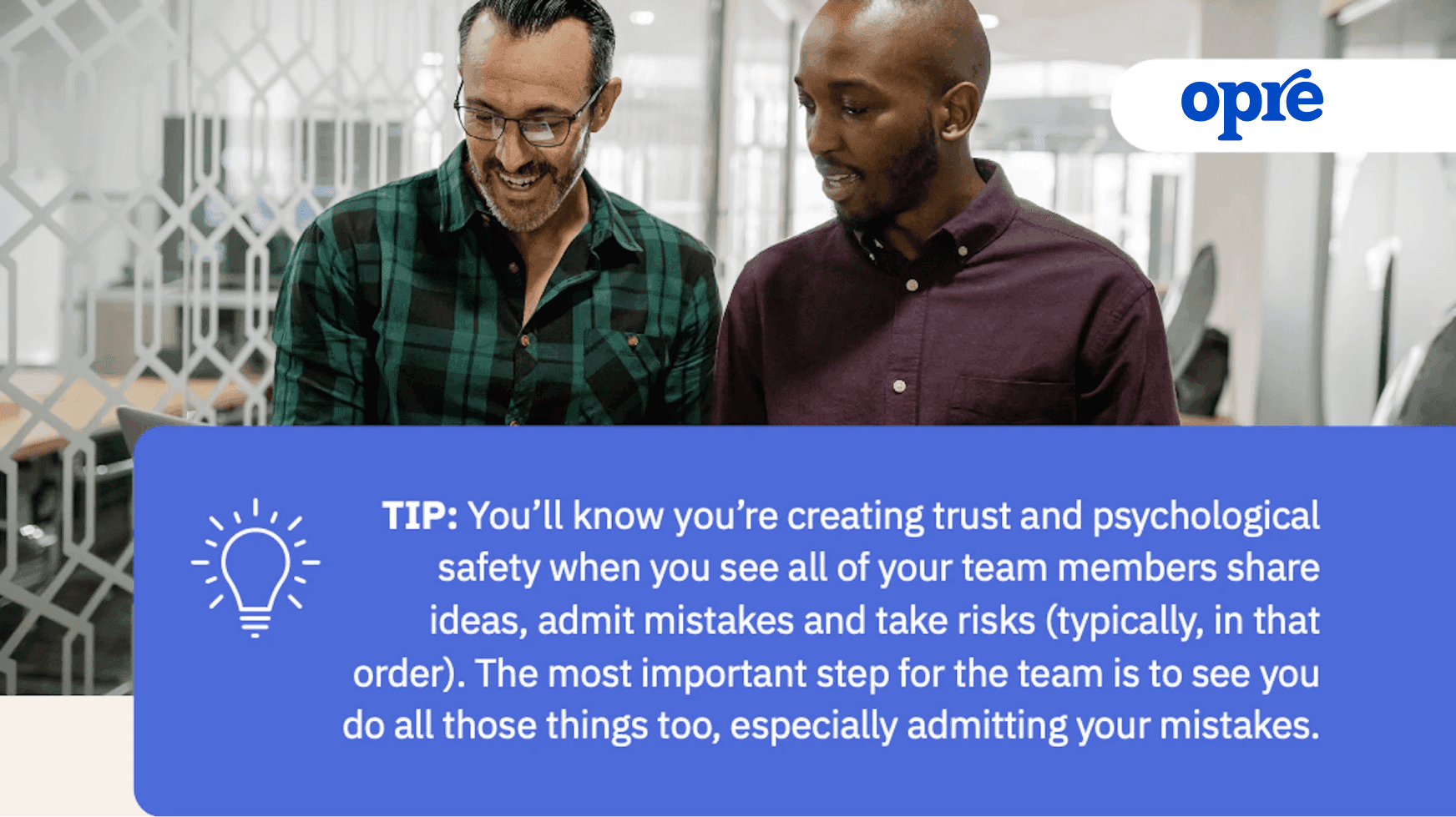
Productive Conflict
What it means
Significant problems, conflicts and divergent opinions are addressed promptly with team members focused on finding the best solution or outcome as opposed to achieving personal victories.
Conflict on a team is inevitable and, contrary to most people’s assumptions, essential and good. Productive conflict is the primary tool for teams to leverage diverse ideas and perspectives. Without it, teams often make poor decisions, fail to produce high-quality work, overlook important improvement opportunities and stifle innovation.
Participants in productive conflict need to feel safe to voice their opinions and ideas without fear of reprisal or judgement, consider and respect all ideas and opinions, and be committed to finding resolutions.
Coaching guidance
It’s important to identify the different types of conflict your team may experience so you can make the conflict productive. There are three types of conflict:
Task conflict is disagreeing about a problem, solution or decision. This type of conflict is the only type of conflict that’s productive, necessary and good for your team.
Encourage your team to establish norms for how they engage in task conflict. Two examples of how you can do this are:
Create decision-making norms. Establishing norms for making decisions helps your team feel safe to engage in task conflict and even to mine for it (more on the benefits of that later).
Mine for task conflict. One of the most effective ways to mine for conflict is to ask team members to take a counterpoint position when it seems the group all agrees on a decision from the start. This behavior has a positive effect on the team in two ways. One: team members learn that they’ll need to take counterpoint positions. It may be uncomfortable for some team members at first, so they’ll learn to prepare for it. Two: team members learn to think about counterpoints before making up their minds because they may be asked to communicate those views in front of the team. It’s important to ask team members to take opposing positions equally.
Status conflict is about our perceptions of the hierarchy of the team and where we fit. It’s less about job titles and more about informal roles. Status conflict can arise over tenure, experience, responsibility or reporting structure.
The best ways to address status conflict are:
Establish respect. Let the other person know that you value them. The best way to do that is to be specific about communicating what you value about them -- their skills, commitment or contributions.
Define roles. Status conflict can be prevented when all team members have clarity about their role and the roles of others. Take time at the beginning of a new project or when a new member joins the team to communicate defined roles.
Relationship conflict is disagreements over differences in personality or values. This type of conflict is disruptive for teams, but it is easy for teams to escalate task conflict into status or relationship conflict. When this happens, ask both team members to review their “ladder of inference.”
The ladder of inference is where most relationship conflicts arise. At the base of the ladder are observations we make about someone’s behavior or perspective. Then, we make assumptions about that behavior, and if we see that behavior repeated, we often draw a conclusion about that person. When conflict arises, we typically argue over our conclusions but the conflict is best addressed at the observation level. When mediating conflict, be sure to remind team members about the ladder of inference and ask them each to walk their own. If reviewing their ladders doesn’t resolve the relationship conflict, remember that most relationship conflicts are over personality. In this instance, remind them to go back through their DISC profiles. Now that you’ve established the ladder of inference as a norm for handling relationship conflict, encourage team members to review their ladder of inferences without you the next time.
Conflict on a team, particularly unproductive conflict, may not always be obvious or visible. This is known as artificial harmony. To you, the team appears to be harmonious, but under the surface team members are either participating in unproductive conflict or avoiding conflict altogether. Often, artificial harmony can present itself when members of the team don’t trust you enough to bring up real problems in a team setting. If you suspect this is the case with your team, establish respect for each team member and then mine for conflict.
How it plays out
Healthy Teams: The team addresses significant problems, conflicts and divergent opinions promptly, with members focused on finding the best solution. Teams continuously engaging in productive conflict find themselves as members of an inclusive team environment.
Unhealthy Teams: The team avoids addressing important problems, conflicts and divergent opinions. When conflict or debate happens it often becomes negative and/ or personal. Over time, unaddressed conflict or destructive behavior can permanently fracture the team.

Commitment to the Team
What it means
Team members consider what is best for the team over their individual wants, even when they don’t personally agree with specific decisions or directions. The most effective teams synthesize available information and viewpoints to collectively make appropriate decisions and understand the direction forward, operating as a unit at all times.
Coaching guidance
Commitment to the team is a continuous process for team members. Commitment doesn’t necessarily mean that everyone agrees on the outcome or path forward out of conflict. Rather, team members feel their viewpoints are being heard and understood by you and the team well enough to be able to put them aside for another path chosen by you or the team.
One very important element to garnering commitment from team members is that you show the team that you can articulate all their opinions about the path forward. It shows you’ve heard, understood and considered everyone’s proposed path.
Practice: Disagree and commit
Not to be confused with “agree to disagree,” disagree and commit is the opposite. Where agree to disagree implies that we can’t come to an agreement and we’re steadfast in our way, disagree and commit means that one team member or side of a disagreement is willing to support the other.
When leading team task conflicts, a good way to practice disagree and commit is to ask team members, “Are you willing to disagree and commit to this?” Another good way to garner commitment is to break down a big commitment into smaller ones. If the team is conflicted over doing project A or project B, ask yourselves if you can break each down into small components to test which one would be more effective in the long term.
How it plays out
Healthy Teams: Team members consider what is best for the team over their individual wants, even when they don’t personally agree with specific decisions or directions. Once decisions are made, all members buy-in and work together to carry them out.
Unhealthy Teams: Team members are unwilling to compromise their personal viewpoints or motives, often at the expense of team performance and outcomes. Decisions are delayed or never made, and decisions that do get made are second-guessed and face resistance.
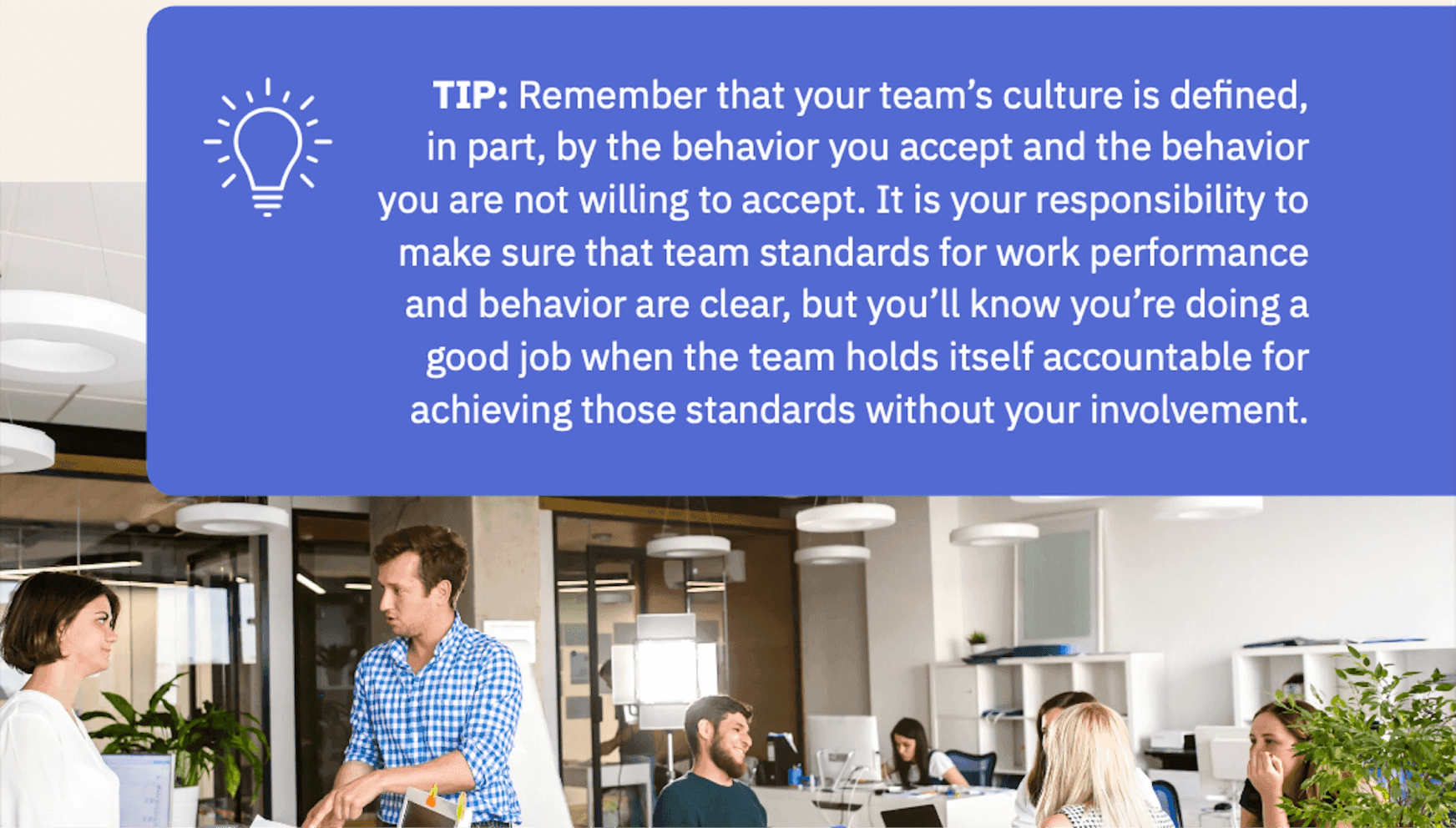
Active Accountability
What it means
Accountability is present on a team when individual members take responsibility for their work and collectively the team is accountable to its stakeholders. It means that team members care about how their behaviors, actions (or lack thereof) and outcomes affect other team members, the team as a whole and team stakeholders.
Active accountability is present on a team when all team members take an active role in helping everyone live up to the team’s standards. Accountability doesn’t just apply to results (e.g. completing work on time); it also applies to the behaviors and standards of how team members act and treat each other. Through active accountability, healthy teams establish a high sense of dependability between teammates and the team as a whole. Specifically, team members can expect consistent levels of performance from themselves and others and clearly understand everyone’s role in contributing to the cohesiveness and effectiveness of the team.
Coaching guidance
Make sure that team members clearly understand (1) their own role and responsibilities, (2) the role and responsibilities of each team member, and (3) the overall goals and commitments of the team.
Some of the best ways to accomplish this include:
Keep documentation of roles and responsibilities up-to-date for all team members, including yourself. (This is a good tool to use in resolving status conflicts, too.)
Find a system for the team to visualize and manage shared work. This helps teams understand how their work impacts others, and they can collectively identify work bottlenecks and mitigate them together.
Hold frequent reviews of team goals and update progress toward goals with the team (more on this next).
Capture learnings, wins and misses with the team when goals are completed so the team can apply these insights to future work.
How it plays out
Healthy Teams: Team members feel a strong sense of responsibility for their personal behaviors and outcomes as well as those of the team, and they hold all their teammates, including the team leader, to the same standard.
Unhealthy Teams: Unclear expectations and/or disengagement and apathy result in team members avoiding responsibility for their behaviors and results, with similar expectations for their teammates and the team as a whole.
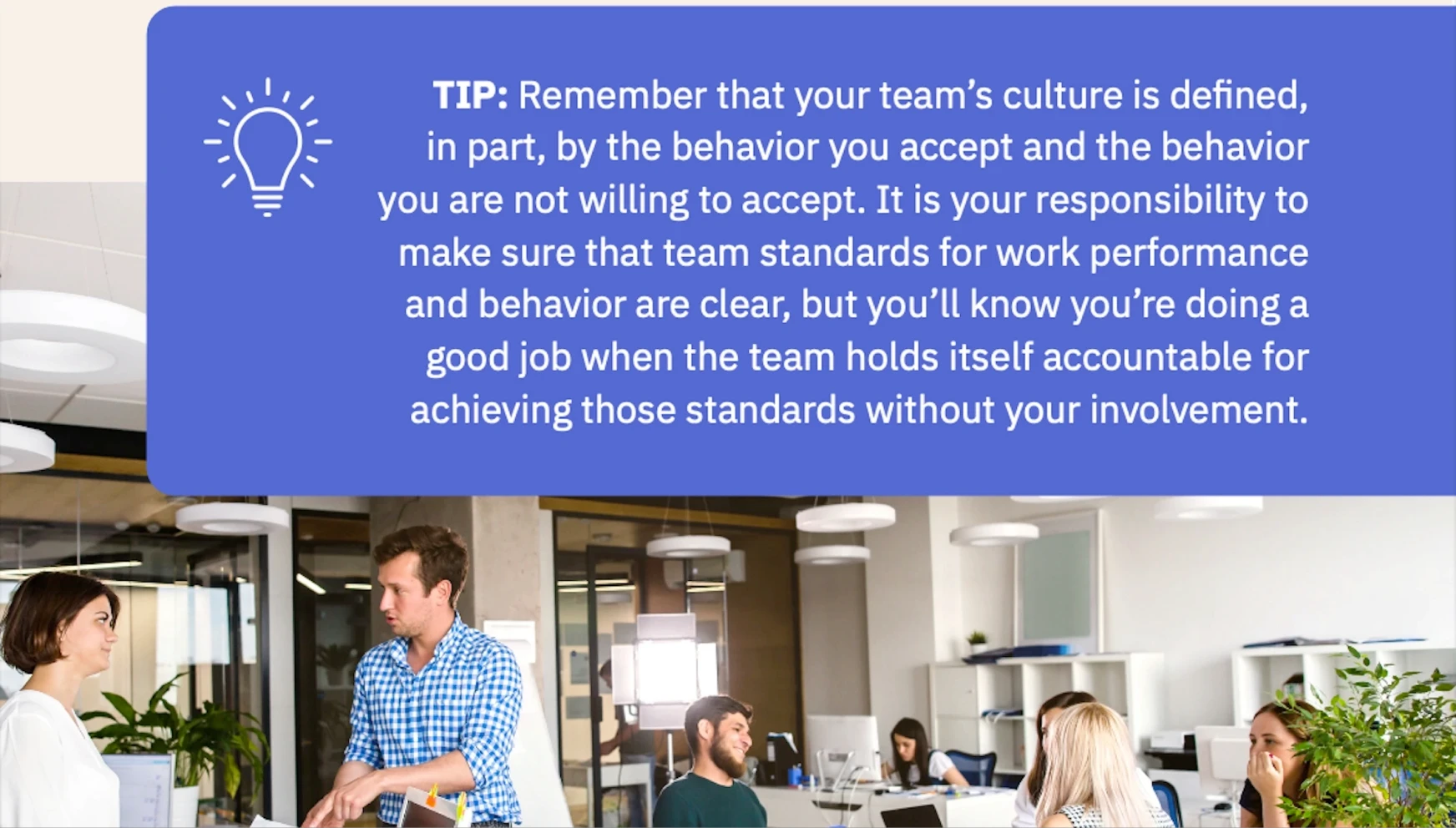
Focus on Achieving Team Goals
What it means
The purpose of any team is to responsibly and reliably deliver value to its stakeholders. While a goal or outcome is often the reason a team is grouped together, it is a very clear understanding of the goal and a continuous focus on it that keeps a team working well.
Goal achievement is how a team is judged, particularly by those outside the team. Healthy teams collectively accept this responsibility, expect to be held accountable to these expectations and have a strong desire to succeed together.
When team members do not receive clear direction, they are vulnerable to a lack of motivation and/or commitment to the team and its outcomes. When this happens, unmotivated members disengage from the team and their work, while ambitious members might pursue personal objectives – both of which greatly hinder the team’s ability to deliver value.
Coaching guidance
A team’s ability to continuously deliver on its goals is also how you are judged, but the key to this Team Health dimension is the focus the team needs on its goals. When you help a team create healthy goal-setting behaviors and set them up to focus on those goals, achievement will come. The vast majority of your team’s effectiveness will be determined by the Team Health factors already addressed in this eBook. Still, it’s important that you set a good example and help the team learn good behaviors for goal setting and achievement.
Here are a few tips for focusing on goals:
Pick and stick to a model for goal setting. (We recommend OKRs –Objective and Key Results. Objectives answer the question, “Where do we need to go?” and don’t contain numbers. Key Results answer the question, “How do I know I’m getting there?” and include specific measurements like revenue, percentage improvement, percentage complete, or simple numeric measurements.)
Ask the team for input when creating goals so that you feel the goals are realistic but also stretch the team. (We recommend setting a quarterly cadence for team goals.)
Visualize the goals in a place where everyone on the team can see them daily. Seeing the goals is the most important element for creating focus on them.
Commit to reviewing the progress of goals with the team weekly or biweekly. Hold yourself accountable for making this happen and set yourself up for building this new behavior by scheduling the meeting far in advance and putting aside time to prepare in advance.
Anything above 80% achievement of your goals or OKRs is a great result. If you find your team is consistently hitting 100%, be sure to set goals that stretch you and the team more.
The key to hitting any goal is building the behaviors that help you get there. In OKR review meetings, point out and reward behaviors that positively impact the goal.
How it plays out
Healthy Teams: Team members clearly understand the goals, values and roles of the team and continuously concentrate on accomplishing exceptional team results.
Unhealthy Teams: Ambiguous or overly ambitious objectives, responsibilities, or expectations lead team members to pursue self-serving objectives, become distracted and waste opportunities, and fail to deliver on the team’s mission to provide value to its stakeholders.

Positive Impact
What it means
The team has a clear understanding of how its efforts provide value and this value is recognized by stakeholders. When teams can see the fruits of their labor and know they are providing value, they experience a sense of accomplishment that helps them develop stronger bonds, be more willing to overcome adversity, remain driven over long or strenuous periods of time and strive to continuously improve the quality of their work.
In order to see and appreciate their impact, teams need to have a clear understanding of who they are impacting and how that impact will be realized. When teams see the positive impact of their work, it creates a feedback cycle that fuels a team’s growth and learning.
On the other hand, teams that can’t see how their hard work makes a significant impact can quickly become discouraged and unmotivated. This produces a negative feedback cycle in which team members can become disengaged.
Coaching guidance
Goals and OKRs do a great job of showing how the work team members do makes an impact on the overall objective, but that’s not enough for the team to feel they’re having a positive impact. Collect feedback from stakeholders whenever possible and always make a habit of sharing it with the team.
Celebrate the team. As the primary champion of the team, take the time to celebrate their achievements. You can start with any win, even if it’s small and infrequent, to build confidence and create a shared sense of accomplishment. Doing so regularly can build momentum so that the accomplishments grow in frequency and magnitude. Celebrations at the team level reinforce that the group succeeds and fails together.
How it plays out
Healthy Teams: The team has a clear understanding of how its efforts provide value to the organization or its customers, either internal or external, and this value is recognized by stakeholders.
Unhealthy Teams: The team doesn’t clearly understand who its stakeholders are and how the team’s efforts benefit them or how the team contributes to the organization’s ultimate mission. Team members feel they are doing work simply because they are told to and don’t see the value of their contributions.
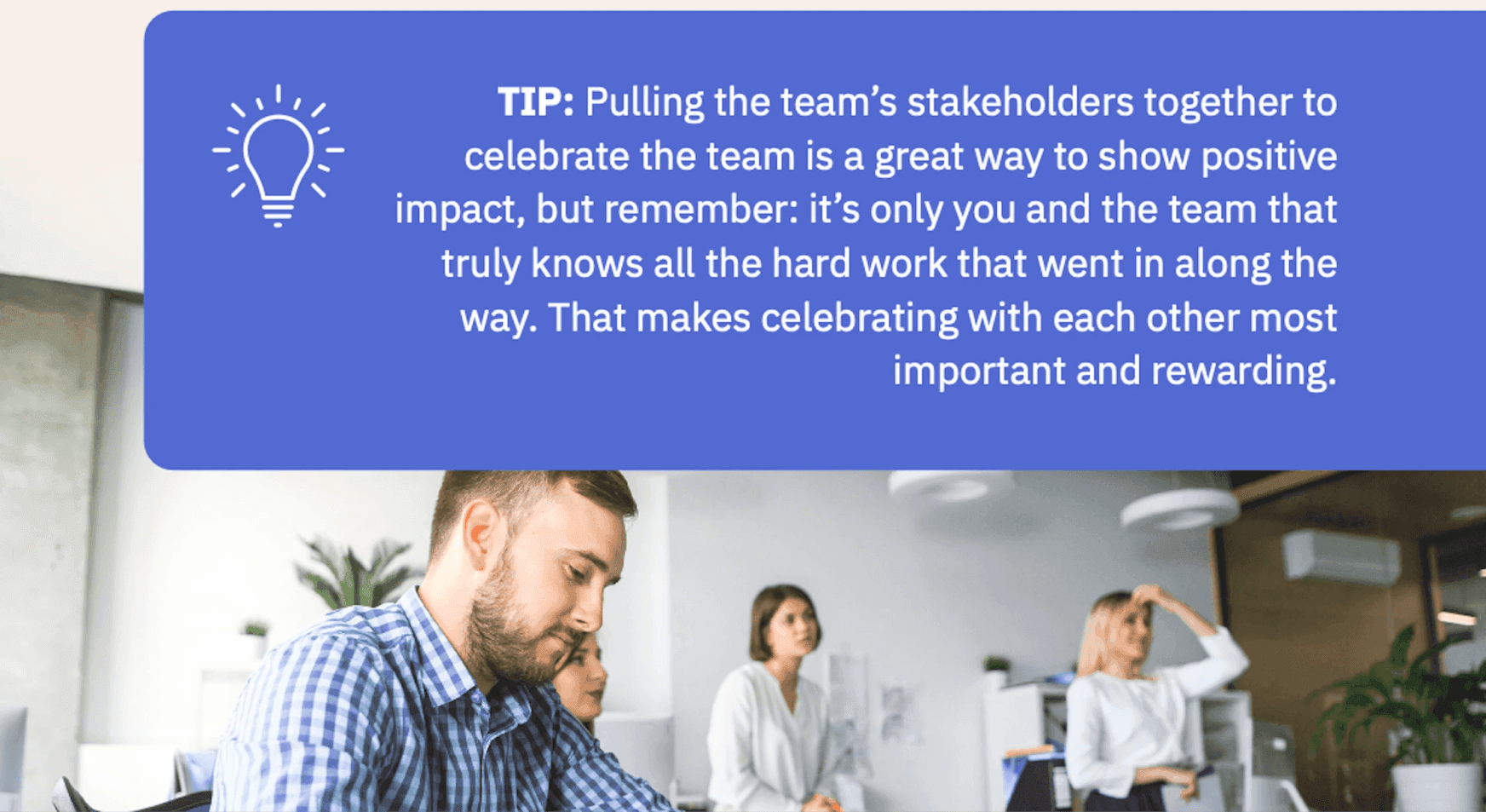
Personal Purpose and Meaning
What it means
Team members find a great deal of purpose and meaning in their work or its outputs. They feel engaged with a sense of fulfillment through their work.
Finding personal purpose and meaning on a team is important because those measures lead to personal fulfillment, an outcome for which we all naturally long. Without fulfillment, team members may find it difficult to maintain high engagement in their work and suffer from low motivation for long periods of time.
Personal purpose and meaning can, and likely will, vary by team member. One person’s primary driver of meaning might be your company’s mission, while another may find it by being a productive member of the team.
Maintaining personal purpose and meaning depends on the presence of two key elements:
A healthy environment in which to operate
The opportunity for personal growth
Teams that establish a culture of learning and growth through the Team Health dimensions experience the benefits of highly engaged, committed and passionate members who continue to push past their limitations and expand their potential.
Coaching guidance
Helping team members find personal purpose and meaning at work requires that you develop a personal relationship with each team member. 1-on-1 meetings are a powerful tool for developing relationships with your team members and gaining a deeper understanding and appreciation of them as individuals.
It is necessary to dedicate ample time to these 1-on-1s in order to:
Explore the team member’s internal motivations and needs, personal ambitions and goals, and preferred learning styles.
Examine and discuss how a member’s internal motivations and personal ambitions influence their ability to find personal meaning and purpose at work. Identify and document ways that you and the team can assist on this journey and provide coaching and guidance to help each individual find their path.
Use the member’s work style analysis to determine the best approach for getting the most from these conversations.
Once you’ve built a trusting, personal relationship, you can work together with each individual to outline Professional Development Goals that align with their expressed ambitions and needs. Working on this plan signals to the member that their development and fulfillment is important to you and the team.
Awarding external incentives such as bonuses, raises or manufactured recognition can sometimes be an immediate reaction for low motivation, but it can rarely combat the downward slide of low engagement. Money isn’t bad, but when used as a way of avoiding the root issues, money is only a short-term, surface-level fix for motivation.
Through it all, it’s important to champion a culture of growth and learning on the team by ensuring that everyone, including you, has a growth plan that’s actively pursued and managed. One of the best ways to accomplish this is to make growth a core value for the team by carving out dedicated time and resources for members to pursue their development objectives, and then celebrating growth and learning accomplishments.
How it plays out
Healthy Teams: Team members find a great deal of purpose and meaning in their work or its outputs, which leads them to feel engaged and gain a sense of fulfillment from their work and experiences.
Unhealthy Teams: Team members struggle to find meaning and purpose in their work and rarely achieve a sense of fulfillment, which leads them to feel disengaged and like they are simply going through the motions.

Conclusion
Congratulations! You’re a leader and a coach. You’re setting your team up for success with individual coaching and the Team Health framework that create a great place to work.